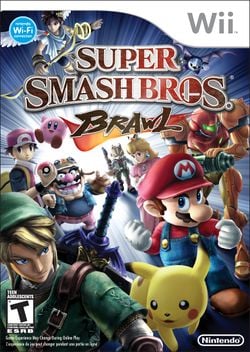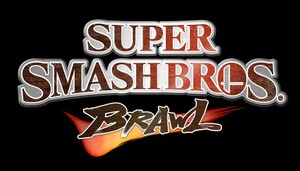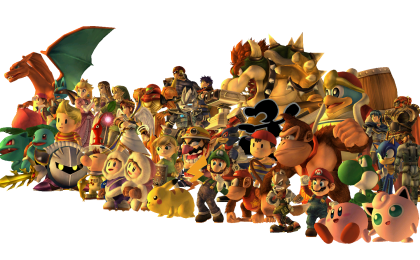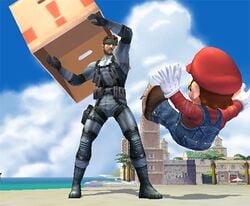Super Smash Bros. Brawl
| Template:FA-articleSuper Smash Bros. Brawl | |
|---|---|
 Official box art for Super Smash Bros. Brawl. | |
| Developer(s) | Sora |
| Publisher(s) | Nintendo |
| Designer(s) | Masahiro Sakurai (director) Kazushige Nojima (scenario writer)[1] |
| Released | |
| Genre(s) | Fighting |
| Mode(s) | Single player, Multiplayer, Online multiplayer[5] |
| Ratings | CERO: A ESRB: T OFLC: PG PEGI: 12+ |
| Media | Wii Optical Disc |
| Input methods | Wii Remote, Nunchuk, Classic Controller, GameCube controller[6] |
Super Smash Bros. Brawl, known in Japan as Dairantou* Smash Brothers X (大乱闘スマッシュブラザーズX, Dairantō Sumasshu Burazāzu Ekkusu), and often shortened to "SSBB" or "Brawl", is the third installment in the Super Smash Bros. series published by Nintendo. Brawl, as with the other games in the series, features a diverse roster of characters from Nintendo and its second parties to fight in various kinds of matches. However, Brawl is the first Super Smash Bros. game to feature third-party characters. Most of the game's music is made up of arranged versions of pieces that originated in previously released Nintendo video games; though some play exactly as they did in their original games, others are arranged by one of 36 renowned video game composers.
As with its predecessors, Super Smash Bros. Brawl is a departure from traditional fighting games, notably in its simplified move commands and its emphasis on ring outs over knockouts. Brawl includes a deeper single player mode than its predecessors; known as The Subspace Emissary, this mode is a side-scroller featuring Brawl's playable characters. The storyline of this mode involves characters persevering under the weight of their own personal histories. Brawl supports multiplayer battles with up to four combatants and is the first game in its franchise to support online battles through Nintendo Wi-Fi Connection.
* Dairantou = "Great Fray"
Intro
<youtube>T6Kn0b9rDyI</youtube>
Characters
- Main article: Character
The cast of characters includes various returning characters from Melee as well as a variety of newcomers. Some returning characters have been updated or refined since their last appearance, either in terms of appearance, fighting capabilities, or both. For example, Link and Fox McCloud have taken on new designs from more recent titles, while Samus Aran has gained the ability to change into a new form, Zero Suit Samus, by using her Final Smash.
Some previously represented series have had more characters added to Brawl. Diddy Kong from the Donkey Kong series and Ike from the Fire Emblem series will make their first appearance in the Smash Bros. series, preceded by Donkey Kong in the case of Diddy Kong and both Marth and Roy in the case of Ike.
Other newcomers are the first to represent their series. These include characters such as Pit, representing the Kid Icarus series for the first time since the 1991 Game Boy game Kid Icarus: Of Myths and Monsters; Wario, from Nintendo's highly successful WarioWare and Wario Land series and an occasional antagonist of Mario's. Captain Olimar also makes an appearance from the Pikmin series into Brawl. Solid Snake, the main protagonist of the Metal Gear franchise, and Sonic from Sonic the Hedgehog are the first third-party characters to appear in a Super Smash Bros. game.
Final List of Characters:
* = Returning Character
- Starters
- Bowser*
- Donkey Kong*
- Diddy Kong
- Fox*
- Ice Climbers*
- Ike
- King Dedede
- Kirby*
- Link*
- Lucas
- Mario*
- Meta Knight
- Olimar
- Peach*
- Pikachu*
- Pit
- Pokémon Trainer
- Samus*/Zero Suit Samus
- Wario
- Yoshi*
- Zelda*/Sheik*
- Unlockables
- Captain Falcon*
- Falco*
- Ganondorf*
- Jigglypuff*
- Lucario
- Luigi*
- Marth*
- Mr. Game & Watch*
- Ness*
- R.O.B.
- Snake
- Sonic
- Toon Link
- Wolf
Unplayable Characters
- Fighting Alloy Team
- Master Hand*
- Crazy Hand*
- Petey Piranha
- Sandbag*
- Rayquaza
- Galleom
- Duon
- Ridley
- Meta Ridley
- Porky Minch
- Tabuu
Collectibles
Returning from Melee are trophies, statuettes of Nintendo characters and objects that can be collected in the game. These trophies give a brief history of the object it shows.[7] In addition to trophies, players will now be able to collect stickers of Nintendo artwork.[8] Players will be able to place stickers and trophies onto virtual backgrounds and record snapshots, which can be sent to other players via Nintendo Wi-Fi Connection.[7][8] Another new item appearing in the game will be CDs, which, when obtained, will offer new music choices for playable stages.[9] By completing stages in the Classic Mode, coins can be earned.[10] The coins can be used to play the Coin Launcher to get stickers or trophies.
Development
At the pre-E3 2005 press conference, the president of Nintendo, Satoru Iwata, announced the next installment of Super Smash Bros. was not only already in development for their next gaming console, but would be a launch title with Wi-Fi compatibility for online play.[11] The announcement was unexpected to the creator of the Super Smash Bros. series, Masahiro Sakurai. Back in 2003, he had left HAL Laboratory, the company that was in charge with the franchises' development and was never informed of this announcement despite the fact shortly after resigning from the company, Iwata said if a new game was to be made, he would be in charge. It was not until after the conference Sakurai was called to Satoru Iwata's room on the top floor of a Los Angeles hotel where he was told by Iwata, "We'd like you to be involved in the production of the new Smash Bros., if possible near the level of director".[12] Although originally announced to be a launch title, Sakurai stated "I decided to become director. And as of May, 2005, I was the only member of the new Smash Bros. development team". Development of the game never actually started until late 2005, and just for its production, Nintendo opened a new office in Tokyo at the beginning of October 2005. Nintendo also enlisted outside help from a company who, at that point in time, just finished development of a major title. Sakurai also stated that these people had spent excessive amounts of time playing Melee. This team will have access to all the original material and tools from the development of Melee, courtesy of HAL Laboratory. Also, several Smash Bros. staff members that reside around the area of the new office have joined up on the project's development.[13][14]
Brawl was absent from Nintendo's Wii showing at its 2006 Pre-E3 press conference. The next day, on May 10, 2006, its first official trailer was unveiled at E3 and at the After-Hours Press Conference, Nintendo officially revealed the game under the name of Super Smash Bros. Brawl. In an interview with IGN, Sakurai said the Wii's motion sensing features might not be included because, "we found that trying to implement too much motion-sensory functionality can get in the way of the game."[15] As far as Wi-Fi play is concerned, Sakurai stated his plan was to include Wi-Fi connection compatibility and online functionality, he goes on to say "one of the primary reasons Super Smash Bros. Brawl was created was that Nintendo, when taking Wii online, wanted to have Smash Bros. to do that".[15] However, as stated on the Japanese version of the Smash Bros. website, "there would be many hurdles to cross," and an online ranking system is unlikely to be implemented.[16] During a test play between Sakurai and Hideo Kojima, creator of the Metal Gear series, Kojima stated that the game feels complete and that Nintendo "could put it out right now and it would sell millions of copies."[17] Starting May 22, 2007, the site has had updates every weekday. Throughout October 18-22, 2007 at the first Entertainment for All Expo show in Los Angeles, California, Nintendo hosted a Super Smash Bros. Brawl tournament.[18]
At the Nintendo Media Conference at E3 2007, it was announced by Nintendo of America president Reggie Fils-Aime that Brawl would be released on December 3, 2007 in the Americas.[19] However, just two months before its anticipated December release, the development team asked for more time to work on the game. During the Nintendo Conference on October 10, 2007, Nintendo of Japan president Iwata announced the delay, saying:
| “ | In order to fine tune Smash Bros., with this unprecedented game depth, we have decided that we have to take a little more time to complete the game than we announced before. We are sorry for the fans that are already anxiously waiting for the launch, but we would like to launch this game on January 24th, 2008 in Japan. As for the North American launch, we will review that too, and our local subsidiaries will make their own announcements.[20] | ” |
On October 11, 2007, George Harrison of Nintendo of America announced that Brawl would be released on February 10, 2008 in North America.[21] Apparently, the American English game was delayed again to March 9th. [22]
Music
- See also: My Music, Music (SSBB), Super Smash Bros. Brawl Main Theme
On May 22, 2007, Sakurai revealed a list of 36 composers providing music for the game. Sakurai stated that he had asked the composers, who come from a variety of companies and have written music for first, second, and third-party games, "to listen to an elite selection of Nintendo music and arrange several of their favorite songs."[23] The game's various stages have multiple musical tracks which players can listen to using the new "My Music" feature, including some songs that were taken directly from other games without any modification or special arrangement. This feature also allows the player to adjust the frequency of how often a song gets played during a stage. It is possible to unlock more songs on this feature by collecting CDs during gameplay.[9]
Masterpieces
- Main article: Masterpieces
Masterpieces are a new feature to the Super Smash Bros. series. They are Virtual Console demo versions of several older Nintendo games, each one featuring at least one of the characters playable in Brawl. Some of them must be unlocked, and all of them have time maximums. Interestingly, the Japanese release has two more masterpieces than the international releases. These two masterpieces are EarthBound and Fire Emblem: Monsho no Nazo.
Inclusion of characters
Sakurai stated that he did not want to emphasize Japan-only characters;[24] in Brawl's cast, only Marth and Lucas have not appeared outside of Japan (with the exception of Marth in Melee). Sakurai also stated there would be no more than three third-party characters;[24] these characters were Snake and Sonic. The inclusion of Konami-created character Solid Snake may seem to conflict with the Super Smash Bros. paradigm — to only include characters from games made by Nintendo and its second parties — but Sakurai said Hideo Kojima "practically begged" for Snake to be included in Melee, which did not happen because the game was too far in development. This in turn led to his appearance in the following game instead.[25] Similarly, Lucas from Mother 3 was intended to be used in Melee, but was left out because Mother 3 was delayed.[26]
Japanese fans were asked to submit their desired characters and musical themes via a forum on the game's official Japanese site, with some possibly appearing in the game. Likewise, fans from other countries were asked to submit ideas on Nintendo's official forums.[27]
Suggestions were no longer being taken as of June 9, 2006. In August 2006, Sakurai and Miyamoto stated that Nintendo was negotiating rights to other third-party characters.[28] The most requested third-party character, Sega's Sonic the Hedgehog, was announced to be in the game on October 10, 2007.[29]
Trailers
Several different trailers for Brawl were released before the game came out. The original trailer was shown at E3 2006 on May 11, 2006 and revealed Solid Snake as a playable character. A second trailer was shown at the Nintendo World 2006 convention in December, and revealed Fox's return as a playable character. A third trailer was shown as the October 10, 2007 Nintendo Press Conference, which revealed Sonic as a playable character. A final trailer showcasing Brawl's adventure mode, the Subspace Emissary, was released on Friday, December 21, 2007. This trailer revealed that Ike and the Ice Climbers would appear in this mode, among other things.
Reception
Brawl was received with positive reviews, with ratings equal or slightly better than Melee. The game's multiplayer was received excellently, but single player, while noted as superior to Melee's, was still only average.
Changes from Melee to Brawl
The most prominent Brawl-Melee change is the new physics. Generally, the game plays slower - every veteran has a slower fall speed, L-cancelling has been removed, and characters must wait a slight amount of time before being able to Meteor Cancel. Most notably, the air dodge does not involve characters shifting in a direction - instead, characters continue on whatever path they were moving before the air dodge. This allows air dodging to not put characters into a helpless state, and it also makes wavedashing impossible. Because of this, some consider Melee to be superior to Brawl.
There have been multiple improvements and additions. With the exception of Luigi's Down Taunt, there are no true spikes; all attacks that have a downwards angle are Meteor Smashes (although some must be sweetspotted) and are harder to land in general. All characters can Meteor Smash with the addition of the Footstool Jump. Characters can grab an edge if they're facing the wrong way which lowers the usefulness of some attacks such as Mario's cape, as well as being able to angle smash attacks while they're being charged. Characters can pummel faster and some can crawl, while others can glide or wall cling, and all of them can swim.
However, there are some changes that were not liked. Hitstun in Brawl is significantly decreased and can be air dodged or attacked out of; this makes true combos almost nonexistent. (Despite this, certain attacks have extreme hitlag.) Not all characters can Meteor Cancel by jumping, and the window for dash-dancing is so small it loses almost all its usefulness. Tether Recoveries are generally less useful than the wall-grappling they replaced. Characters must wait an amount of time before being able to move after grabbing an edge. Shieldstun is also drastically decreased, has increased Perfect Shield window, and it only takes 7 frames to shield drop, making the game even more focused on defensive game. There is also a landing lag glitch on several characters (not all) that makes them get the landing lag the next time it lands from the air if using a move that makes helpless and grabs the ledge after using a such move.
There are various other changes, including the addition of the Final Smash. Some characters can grab-release others quite reliably. Moonwalking has been removed. CPUs generally gained an AI increase but do not DI very much - perhaps because it has been limited, although easier to do. Grabbing a character does not restore their double jump(s), and short hopping is made easier as characters are a bit slower at jumping. Smash Taunts do not end if the user flinches; he has to be KO'd to end it early.
Outside of the main game, players can build custom stages and save snapshots and replays. Melee's Adventure Mode has evolved into The Subspace Emissary, while Event Matches have selectable difficulties and the Home-Run Contest puts a temporary shield around the platform - all of these modes can also be played in co-op. Players can also play online in various modes.
Trivia
- To the dismay of many NTSC/PAL owners of Brawl, the game does not come with Japanese audio or text options as did Super Smash Bros. Melee.
- Oddly, this is the first game in the series that any character has a beard (Snake, Ganondorf, and Kirby if he copies Snake's special move).
- The announcer does not yell the game's title at the title screen, unlike the other games in the series.
- The opening does not show hidden characters (such as Toon Link, Wolf, etc.) until you unlock them, like in the first Super Smash Bros., with the exception of Ness, Marth, Falco, Sonic and Snake.
- Some non-human characters (like Donkey Kong and Diddy Kong) use more realistic sounds rather than their usual cartoonish sounds in their own games.
- The Brawl menu was designed almost identically to Kirby Air Ride.
- While the Wii Remote speaker is generally unused, there are two instances where it is used:
- When a player selects a character, the character will make a noise through the speaker.
References
- ^ Cite error: Invalid
<ref>tag; no text was provided for refs namedIwataAsksSubspace - ^ Upcoming Nintendo titles for Wii and Nintendo DS across Europe. Nintendo-Europe. Retrieved on 2007-07-11.
- ^ "Look who is attending the Brawl!", Nintendo, 2007-10-10. Retrieved on 2007-10-10.
- ^ Super Smash Bros. Brawl at Nintendo Australia. Nintendo (2006-05-12). Retrieved on 2007-06-20.
- ^ Wi-Fi Play. Smash Bros. DOJO!!. Smashbros.com (2007-09-18). Retrieved on 2007-09-18.
- ^ Four Kinds of Control. Smash Bros. DOJO!!. Smashbros.com (2007-06-08). Retrieved on 2007-06-08.
- ^ a b Trophies. Smash Bros. DOJO!!. Smashbros.com (2007-09-24). Retrieved on 2007-10-24.
- ^ a b Stickers. Smash Bros. DOJO!!. Smashbros.com (2007-08-15). Retrieved on 2007-10-24.
- ^ a b My Music. Smash Bros. DOJO!!. Smashbros.com (2007-09-07). Retrieved on 2007-10-28.
- ^ Cite error: Invalid
<ref>tag; no text was provided for refs namedclassic - ^ Casamassina, Matt (2005-05-17). E3 2005: Smash Bros. For Revolution. IGN. Retrieved on 2006-05-03.
- ^ IGN Staff (2005-11-16). Smash Bros. Revolution Director Revealed. IGN. Retrieved on 2007-06-21.
- ^ Gantayat, Anoop (2005-12-05). Sakurai Elaborates on Smash Bros. Revolution. IGN. Retrieved on 2007-06-21.
- ^ Cite error: Invalid
<ref>tag; no text was provided for refs namedfamitsu - ^ a b Casamassina, Matt; Peer Schneider (2006-05-10). E3 2006: Super Smash Bros. Brawl. IGN. Retrieved on 2006-08-01.
- ^ Miller, Ross (2006-06-05). Sakurai reveals new Smash Bros. Brawl details. Joystiq. Retrieved on 2007-06-21.
- ^ Dormer, Dan (2007-04-27). Kojima's Played Super Smash Bros. Brawl. 1up.com. Retrieved on 2007-06-21.
- ^ Wirgler, Matthew (2007-10-09). Super Smash Bros. Brawl and Mario Galaxy Playable at E for All. Advance Media Network. Retrieved on 2007-10-21.
- ^ Casamassina, Matt (2007-07-11). Nintendo E3 2007 Press Conference. IGN. Retrieved on 2007-07-11.
- ^ Nintendo Conference Fall 2007 (mpg). E-news.co.jp (2007-10-10). Retrieved on 2007-10-11.
- ^ Smash Release Date Confirmed. Retrieved on 2007-10-14.
- ^ Brawl Delayed Again (2008-01-15).
- ^ The Musicians. Smash Bros. DOJO!!. Smashbros.com (2007-04-27). Retrieved on 2007-09-14.
- ^ a b Klepek, Patrick (2006-06-05). Super Smash Bros. Brawl Details. 1UP. Retrieved on 2007-09-13.
- ^ Mcwhertor, Michael (2006-05-11). E306: Super Smash Bros. Brawl Q&A. Kotaku. Retrieved on 2007-09-18.
- ^ 速報スマブラ拳: Ness (Japanese). Nintendo. Retrieved on 2007-10-21.
- ^ E3 2006: Fans Asked to Fill Smash Bros. Roster. IGN (2006-05-11). Retrieved on 2006-05-11.
- ^ Rushan S. (2006-08-17). Sakurai and Miyamoto Comment on Sonic's Popularity. Nintendo Wii News. QJ.NET. Retrieved on 2007-08-04. “Nintendo hopes that Snake's appearance in Super Smash Bros. Brawl will encourage other publishers to allow their characters to join the Smash Bros. line-up, and is already actively negotiating for the rights to include at least one other non-Nintendo character.”
- ^ Sonic The Hedgehog. Smash Bros. DOJO!!. Smashbros.com (2007-10-10). Retrieved on 2007-10-10.


